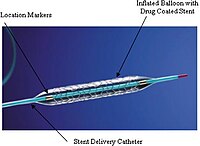
Photo from wikipedia
BACKGROUND Neoatherosclerosis after drug-eluting stent (DES) implantation is known to be related with increased risk of late restenosis and stent thrombosis. Neoatherosclerosis and relevant clinical outcomes between bioabsorbable polymer DES… Click to show full abstract
BACKGROUND Neoatherosclerosis after drug-eluting stent (DES) implantation is known to be related with increased risk of late restenosis and stent thrombosis. Neoatherosclerosis and relevant clinical outcomes between bioabsorbable polymer DES (BP-DES) and second-generation durable polymer DES (DP-DES) were evaluated by optical coherence tomography (OCT) analysis. METHODS A total of 311 patients (319 lesions) undergoing OCT analysis after DES implantation were enrolled and divided into two groups according to stent type (BP-DES [150 patients, 153 lesions] and DP-DES [161 patients, 166 lesions]). Follow-up OCT analysis was performed at least 9 months after index stent implantation. Neoatherosclerosis was defined as presence of thin-cap fibroatheroma, calcified plaque, and lipid plaque. Primary endpoint was the incidence of neoatherosclerosis, and the secondary endpoints were the occurrence of major adverse cardiac events (MACE), defined as a composite of death, myocardial infarction, target lesion revascularization, or stent thrombosis and to find independent predictors of neoatherosclerosis. RESULTS The incidence of neoatherosclerosis was lower in the BP-DES group than the DP-DES group (5.2% vs. 14.5%, p = 0.008), which was driven by lipid plaque. However, the incidence of MACE did not show statistical difference between the two groups in median 4-year follow-up (3.3% vs. 7.8%, hazard ratio 1.964, 95% confidence interval 0.688-5.611, p = 0.207). Less use of angiotensin converting enzyme inhibitors/angiotensin II receptor blockade and higher degree of neointimal hyperplasia remained independent predictors of neoatherosclerosis on Cox regression analysis. CONCLUSIONS Patients undergoing BP-DES implantation had lower incidence of neoatherosclerosis than DP-DES, which did not reach statistically better clinical outcomes.
Journal Title: Cardiology journal
Year Published: 2022
Link to full text (if available)
Share on Social Media: Sign Up to like & get
recommendations!